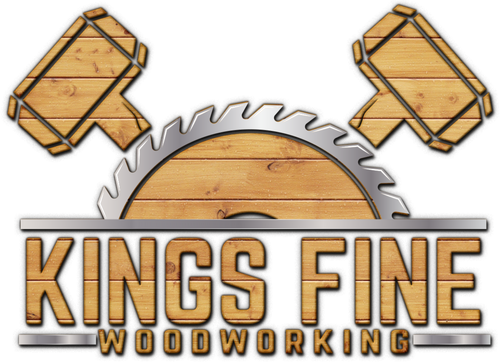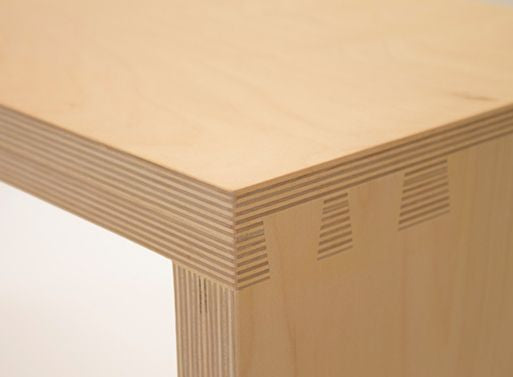Article:
Baltic Birch Plywood is a plywood built using a specific method. It comes from Baltic states in Northern Europe.
Baltic Birch plywood is generally regarded as being of higher quality than standard birch plywood. It is made entirely from birch plies, and unlike regular plywood it has no softwood or filler plies in the center.
Also the plies themselves are thinner, allowing for more plies for a given thickness and they are a uniform 1.5mm thick. This gives it much greater stiffness and stability.
Additionally the outer ply (face veneer) is also 1.5mm thick. Which is about double that of regular hardwood plywood. (Typically walnut, maple, birch, and oak plywood have outer veneer layers that are only 1/30” or 1/32” which is about 3/4mm).
Baltic Birch is glued up with a waterproof glue, which can make it useful in damp situations.
Baltic Birch is superior in screw holding. Which is critical in woodworking. In traditional plywood there are many voids. If a screw penetrates a void, there is no holding strength where the threads meet no wood. And even if it doesn’t hit a void, the core of traditional ply is usually softwood. This doesn’t give nearly the strength of a screw holding in hardwood, which is what Baltic Birch is, since every layer is made of the same hardwood birch.
Joinery is also stronger and better looking in Baltic Birch. Being void free, joints don’t break apart when cutting dovetails or finger joints. And rabbets & dados are better too with no chance of de-lamination. Plus it provides for a very unique & clean look.
Baltic Birch is also significantly stronger. Since there are no voids, there is a consistent layer of glue and every square inch of material from top to bottom is fully bonded. It also has more dimensional stability. In many traditional plywoods there are 5-7 layers for a 3/4” sheet, whereas the same thickness of Baltic Birch has 13 layers. Since it has more layers, and the grain directions alternate it is even less likely to shrink or expand.
However, Baltic Birch also has drawbacks. It typically costs more than regular plywood. And in many locations it is only available in 5’ x 5’ sizes, or a smaller derivative of that. The reason for this is that it’s the preferred size for European cabinetry. (Although some places do have 4’x8’ sheets available). It is typically not sold in big box home improvement stores, which means it isn’t as widely available. Usually it must be bought at a hardwood dealer or woodworking specialty place.
For the woodworker, Baltic Birch can be a fantastic asset. It is an excellent and affordable product for drawer boxes. It holds together tightly with screws even in small pieces without falling apart. And it has great strength & durability for the many jigs and fixtures that the woodworker needs.


BALTIC BIRCH PLYWOOD: What is it? Why is it better?
Comments (16)
I’ve used Baltic Birch in the past and loved the quality. Since it’s so popular, I’m really puzzled why American manufacturers don’t offer anything even close to it quality-wise. Even the supposedly “good” American plywood is crap by comparison, so what’s the deal? It’s not magic.
Better use your local birch, there will be hardly any trees in the Baltics if it will be cuted down in the same amount as it is now.
I want to buy some Vix bits on my Amazon Smile Prime account and give you the credit for them. However, I do not want to use the link in your video because, it does not go to Amazon Smile. Do you have a suggestion?
Thank you,
Chris
one specific question about Baltic birch plywood that I have always wondered about and it is in the “…preferred size for European cabinetry…”, Why is that? Is it dimensioned (5×5) to account for less waste while making cabinets, or 1 cabinet from one sheet?
Where does can you Baltic Birch plywood that is flat? Big box store no, I’ve ordered online and that hasn’t worked well either.
Thanks, Ken
I have watched many of your videos. Now I have the time to try and re-create some of your projects. Thanks for the great informational videos>
“the plies themselves … are a uniform 1.5mm thick.”
If 18mm Baltic Birch has 13 plies, that’s comes out to 1.38mm per ply, does it not? Or, If each of the 13 plies were truly 1.5mm, that would make the plywood 19.5mm in total. I’ve never understood this part.
King’s Fine Wood Working,,, yes and a Fine Family of Wood workers and all connected by the Union of Family,,,where everyone chips in and is valued member of a Team,,, More than Fine,, King’s Fine Quality of All Kinds… I am now a member non paying and seeking someone to cover my dues,,, so I feel like I can contribute..
Happened upon one of your YouTube videos and then watched all I could find. Nice work and great explanations of everything you’re doing. Makes me brave enough to try some new things and get in to areas I never thought I would. Keep up the great work and I look forward to the next video and beyond. Your helpers (family) are great and learning the trade. Keep building quality projects. You have a gift.
I found your channel and was clearly astounded. You and your girls are well trained as well as well versed in your trade. You did very well in training them, and I realize we all continue to learn. Please keep up the good works.
I am a retired disabled vet and would like to do so much more, but the cost of exotic woods and high end ply-woods make that nearly impossible. I hope to make a few things and maybe show that some of these things you show here can be made on the lower end as well, lol. till I meet you again on your next video, have a great life.
P.S. I love that router portable table so much, hope I can deliver it in the way you did.
been doing woodwork all my life after school, nothing else I will rather do its a good feeling when you finish a project to step back and look . I know how You and Family feels about your Projects LOVE them looking forward to see more. best Regards MR
My English is not so good. I am French speaking from Québec, Canada
I like your FINE work, and you have a nice family congratulation.
Looking forward to your next project.
Just wanted to say” Thanks You” for all the great content you produce. I really enjoy the show. Being that I’ve just started woodworking the last year and a half having a knowledgeable and experienced site to draw information from truly fuels my drive and ever growing passion for this beautiful craft. Again, thank you so much!!
Found your site this week.
Being a retired carpenter / site manager ifind your projects well thought out and enjoyable to watch. Many thanks to you and your family.
Bob
Is this typically more expensive then say oak or cherry ply?
Love wood work, now retired and looking to enjoy woodworking, searching for a work bench that’s when I met you and your family working the amazing bench… Now the sled… I added you to my favorite list and will come again… Keep the good work regards to all your family too…